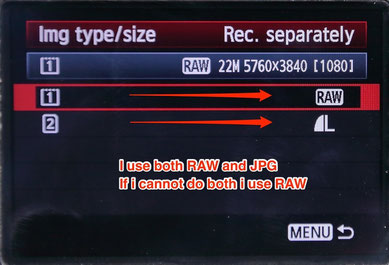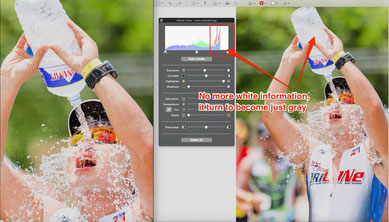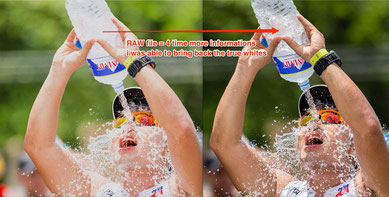So, RAW photos or JPG? What are the differences between a photo in RAW and JPG?
Which one is better a RAW picture or a photo in JPG?
But first at all to make things more clear and very simple. JPG and JPEG are exactly the same thing, and CR2, NEF, DNG, or whatever your camera
give you as a RAW file name are also the same thing (CRW or CR2 is a RAW file like NEF or DNG, etc...).
Even between professional photographers the raw versus jpg can be a big controversy, although 90% of them shoot RAW, but what about the residual 10% who shoot JPG?
Because the big majority of the professional photographer shoot RAW you might think they are right and the 10% who shoot JPG are wrong?

Nobody is right nor wrong! It depend the situation, the photographer's skills and knowledge. It is also about what the photographer is shooting and why he or she is shooting jpg or raw.
And you, are you shooting jpg or raw? Why?
If your answer is "i shoot JPG because JPG take less place on the memory card than a RAW" it means that you have absolutely no clues nor ideas what you are speaking about!
Having said that, and before to continue the infinite debate between raw or jpg, you need to understand the difference between a raw file and a jpg pics, and what you can do with a raw image and what you cannot do with a jpg picture.
This topic might be a bit long because it is aimed from people who never take their cameras off from automatic mode with JPG by default, to all the way up to advanced photographers and beyond which only shoot in RAW, and everywhere in between.
What is a RAW picture: Roughly a RAW is not even a photo, it's just a pack of
data, that some of you might not even be
able to read on their own computer, because for that you need a "codec" or a software which will read the JPG inside the RAW file or a codec which will interpolate the RAW file
in a way that it will allow you to see it as a picture.
What is a JPG photo: JPEG or JPG is a lossy compression of the RAW file produced by your camera, it's called lossy compression because it is not possible to bring back all the information from the original RAW file, those information are lost forever.
How the camera does RAW or JPG?
Let's explain how it work, and for that we need to get a little bit inside your camera at the sensor level.
When you take a picture each tiny pixel inside the sensor encode the amount of light it receive in a file. Those data are encoded on 1024 values (bits), and this file is the RAW file!
After creating this RAW file, your camera will apply the parameters of the camera, that you have chosen, to this file.
Often called user's presets or styles like the white balance, contrast, sharpness, saturation or the very often called standard style, those are the parameters that you have chosen even if everything is in auto, the auto mode is also a "chosen" parameter.
But let's get back on track, so after creating the RAW image, your camera will apply the parameters you have chosen (even the auto mode) to the RAW file and will re-encode the RAW file with your styles or presets in a file which is not anymore a 1024 bits format but a 256 bits (values) format, so with four time less values, and this one is the JPG picture.
But it's not finish yet, to get more space, the camera take those values, and take also the similar values and do an average of that and record only this average of values (bits).
After all those calculations, your camera save the final JPG image on the memory card and erase the RAW file from it hardware's processor.
All cameras, even those from the smartphone or webcam work in this way. But only some high end cameras like some bridge cameras or DSLR allow you to save not only the JPEG picture but also the file straight from the sensor which is the RAW file.
What can i do with a RAW file and what i cannot do with a JPEG file?
In all case if you shoot only RAW you will need to edit and develop it to become another kind of file like a JPEG and be readable everywhere.
Having said that, i will give you just one example about what you will be able to do with a RAW picture and and what you cannot do with a JPEG image.

Imagine you are shooting JPEG only and your picture is over exposed like the example on the side, where the whites are blown out.
So in post processing you would like to bring them back (the whites) to see the bottles and the water more clearly.
Because a JPEG have (at least) 4 times less information than a RAW file, all the whites, in the example on the right side, are just lost, and without information, it's impossible to bring back the over exposed white.
Why? Simply because there is no more information about whites like it's shown in the histogram (the graphic in the middle is called histogram).
And if you insist on trying to bring the white back, the only thing that you will be able to do is to grey those whites, that's all!

On the other hand, if this picture was shot in RAW, you get a different story, and as you can see on the side, all the whites have been brought back and the picture now look a lot better.
Just look at the water bottle on the side, you can even clearly see that it was a very cold water, where before you was just guessing. RAW file got a lot of valuable information that the JPG picture has lost ... forever.
Shooting RAW is for who and JPG is for what?
After all, it is all about post processing or in camera processing, it is all about what are your
need or not.
If you are taking 200 snapshots from your holidays you can do it in JPG because all you want it's only souvenirs, but if you want to take a picture in bad light or you are not sure about your setting and choice you need to shoot in RAW to be able to master most of aspects of your photograph in post processing.
Most of the professional photographers shoot in RAW because they are selling pictures. They want to be able to master the post processing or at least have a lot more options than the JPG can offer.
But some professional photographer are shooting mostly JPG, so to let you understand why some professional photographers are shooting JPG in some conditions let's get with a story i read somewhere, long time ago.
It's an event photographer who asked a question to a sport photographer during the football world cup (soccer).
"are you shooting in raw?"
The sport photographer answered:
- Do you think that i have time to shoot raw to post process those pictures ? They need to be online right away! I shoot jpg, because i do not have time to play with LightRoom!
Because after all, RAW or JPEG is about post processing in camera or out of camera. Meaning also spend a lot of time on your computer to develop the RAW files if you shoot RAW.
It's also about you, if you are confident or not with your setting for an "in camera processing" and get the JPG right away out of your camera or if you prefer a desktop computer development to master in deep your photographs.
I should say about the in camera JPG: Nowadays high end camera can truly well develop a Raw to jpeg, they do it very well and the photos can be very beautiful straight out of camera with your "in camera" own "Preset" or "Styles".
But in JPEG mode you need always to remember, if you have screwed somewhere during the shot, you will often not be able to repair your picture, at least not as far as the RAW can.
And what about me? I shoot RAW and JPG at the same time!
Why ? Because i do my own presets and styles directly from the camera and very often i am happy with what i got straight out
of the camera, but if for any reasons i do a bad picture, i still have the RAW to allow me to repair where i screwed, but the most important in my opinion is that may be in 10
years from now, i might not like anymore the styles i used nowadays and i will be very happy to have kept the RAW to re-edit in a way i might like better in the
future.
A tips for Canon DSLR users who want to shoot only JPG or JPG and RAW like me, or for people who just not want to spend time on a computer.
Canon give you with your DSLR a free software called PictureStyleEditor and this free editor allow you to edit
your own picture styles and upload them in your camera to get your JPG straight out of the camera with your personal
touch.
At the end RAW or JPG?
In my own opinion, with knowledge you can do what you want, you got the knowledge so you assume for your choices but you should also know that it is not because 90% of the people throw themselves in the water that you should jump in it too.
If you like this page let me know it in a comment below (read the rules) and don't forget to share it now on your favorite social media.
Thank you for your support.

Write a comment
Walgreens Photo Coupons (Wednesday, 05 July 2017 10:00)
Great job for publishing such a beneficial web site. Your web log isn’t only useful but it is additionally really creative too. There tend to be not many people who can certainly write not so simple posts that artistically. Continue the nice writing